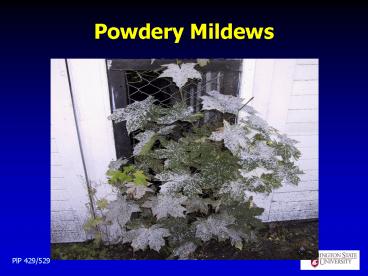Powdery Mildews PowerPoint PPT Presentation
1 / 23
Title: Powdery Mildews
1
Powdery Mildews
2
Powdery Mildews
- Foliage, stems, flower, fruit diseases
- Characteristic gray, powdery growth on
- infected plant parts
- Distortion of host tissue
- Small, black structures may appear
- ascocarps ( cleistothecia)
- Obligate parasites
3
Mycelium Conidia
Powdery Mildew of Pea Cherry
4
Ascocarps (cleistothecia) on host
5
Powdery Mildew of Wheat
6
- Genera are distinguished by
- 1) appendages on the cleistothecium
- 2) number of asci inside each cleistothecium
7
Ascocarp appendages
- Mycelioid resemble hyphae, indefinite
- eg. Erysiphe, Blumeria, Sphaerotheca
2) Rigid bulbous base and pointed tips
eg. Phyllactinia
3) Rigid curled tips eg. Uncinula
4) Rigid dichotomously branched tips eg.
Microsphaera, Podosphaera
8
mycelioid
9
(No Transcript)
10
(No Transcript)
11
One ascus per ascocarp Sphaerotheca Podosphaera
- mycelioid
- dichotomously branched
Several asci per ascocarp Erysiphe Microsphaera Un
cinula Phyllactinia
- mycelioid
- dichotomously branched
- curled tips
- bulbous base
12
One ascus per ascocarp
Podosphaera
13
More than one ascus per ascocarp
Uncinula
http//www.pacificcoast.net/mycolog/chapter4e.htm
14
Chains of conidia
http//www.pacificcoast.net/mycolog/chapter4e.htm
15
Powdery Mildew Lifecycle
Haustoria penetrate the host epidermal cells
directly
primary
secondary
APSnet
16
Blumeria graminis haustorium in epidermal cell
L.M. Carris
17
Powdery Mildew of Rose
- Causal agent Sphaerotheca pannosa
- Worldwide occurrence - both field- and
greenhouse-grown roses - Disease cycle differs between field and greenhouse
18
Powdery Mildew of Rose
Symptoms signs
- Most common on young, succulent tissues
- Small, blister-like lesions
- Gray powdery growth on infected plant parts
- Distortion
- Cleistothecia
19
Powdery Mildew of Rose
http//cygnus.tamu.edu/Texlab/Shrubs/Rose/rsp.html
20
Powdery Mildew Disease Cycle for Rose
2 Cycles
http//www.ipm.ucdavis.edu/PMG/PESTNOTES/pni7493-2
.html
21
Powdery Mildew Diseases
Environmental factors
- Warm, dry weather diseases
- High relative humidity sufficient
- Free water NOT required for conidial germination
or penetration of plant - Sporulation requires dew
- Cool autumn weather stimulates cleistothecium
development
22
Powdery Mildew Diseases
Control
- 1. Foliar Fungicides
- sulfur-containing, systemic
- 2. Disease-resistant varieties
- 3. Sanitation
- removal of infested plant debris
23
Todays Exercises
- Powdery Mildews
- - collecting trip to obtain fresh material
- - observe signs and symptoms
- - make mounts and observe ascocarps
- Previous labs works
- - examine the fruits (lab2)
- - observe the wheat and grass roots (lab3)
- - record the results of tests (lab4)

